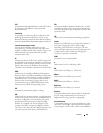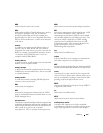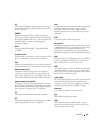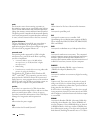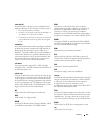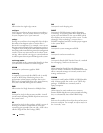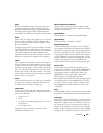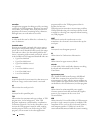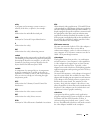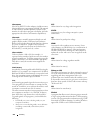
Glossary 209
status
Refers to the health or functioning of an object. For
example, a temperature probe can have the status
normal if the probe is measuring acceptable temperatures.
When the probe begins reading temperatures that
exceed limits set by the user, it reports a critical status.
SVGA
Abbreviation for super video graphics array. VGA and
SVGA are video standards for video adapters with
greater resolution and color display capabilities than
previous standards.
To display a program at a specific resolution, you must
install the appropriate video drivers and your monitor
must support the resolution. Similarly, the number of
colors that a program can display depends on the
capabilities of the monitor, the video driver, and the
amount of video memory installed in the computer.
switch
On a computer system board, switches control various
circuits or functions in your computer system. These
switches are known as
DIP
switches
;
they are normally
packaged in groups of two or more switches in a plastic
case. Two common DIP switches are used on system
boards:
slide
switches and
rocker
switches. The names
of the switches are based on how the settings (on and off)
of the switches are changed.
syntax
The rules that dictate how you must type a command
or instruction so that the computer understands it.
A variable's syntax indicates its data type.
system board
As the main circuit board, the system board usually
contains most of your computer's integral components,
such as the following:
• Microprocessor
•RAM
• Controllers for standard peripheral devices, such as
the keyboard
• Various ROM chips
Frequently used synonyms for system board are
motherboard
and
logic board
.
system configuration information
Data stored in memory that tells a computer what
hardware is installed and how the computer should be
configured for operation.
system diskette
System diskette is a synonym for
bootable diskette
.
system memory
System memory is a synonym for
RAM
.
System Setup program
A BIOS-based program that allows you to configure
your computer's hardware and customize the computer's
operation by setting such features as password protection
and energy management. Some options in the System
Setup program require that you reboot the computer
(or the computer may reboot automatically) in order
to make a hardware configuration change. Because the
System Setup program is stored in NVRAM, any
settings remain in effect until you change them again.
system.ini file
A start-up file for the Windows operating system.
When you start Windows, it consults the
system.ini
file
to determine a variety of options for the Windows
operating environment. Among other things, the
system.ini
file records which video, mouse, and
keyboard drivers are installed for Windows.
Running the Control Panel or Windows Setup program
may change options in the
system.ini
file. On other
occasions, you may need to change or add options to
the
system.ini
file manually with a text editor, such
as Notepad.
table
In SNMP MIBs, a table is a two dimensional array that
describes the variables that make up a managed object.
termination
Some devices (such as the last device at each end of a
SCSI cable) must be terminated to prevent reflections
and spurious signals in the cable. When such devices
are connected in a series, you may need to enable or
disable the termination on these devices by changing
jumper or switch settings on the devices or by changing
settings in the configuration software for the devices.



